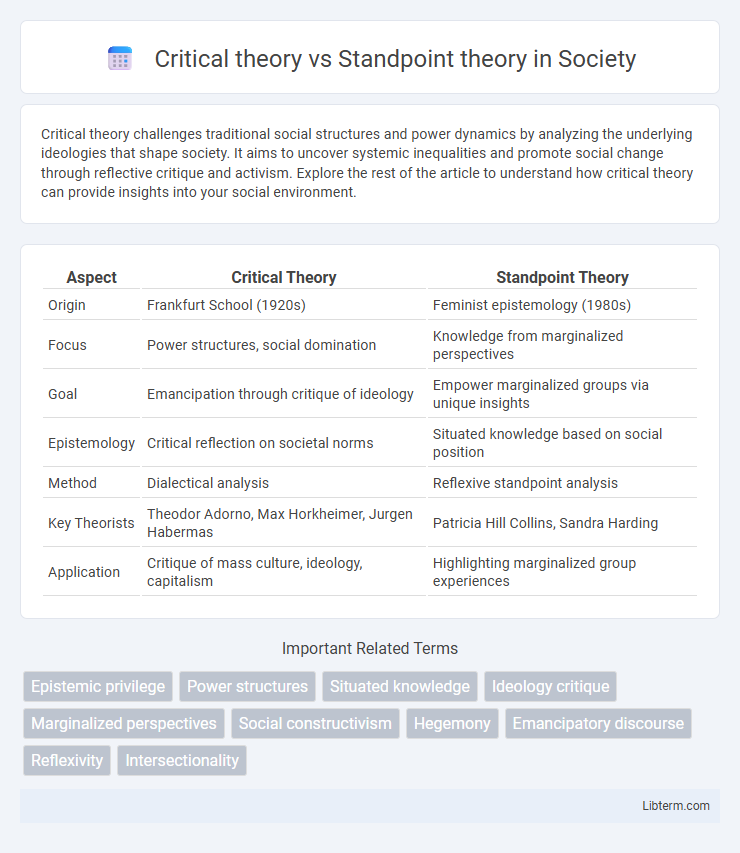Critical theory challenges traditional social structures and power dynamics by analyzing the underlying ideologies that shape society. It aims to uncover systemic inequalities and promote social change through reflective critique and activism. Explore the rest of the article to understand how critical theory can provide insights into your social environment.
Table of Comparison
| Aspect | Critical Theory | Standpoint Theory |
|---|---|---|
| Origin | Frankfurt School (1920s) | Feminist epistemology (1980s) |
| Focus | Power structures, social domination | Knowledge from marginalized perspectives |
| Goal | Emancipation through critique of ideology | Empower marginalized groups via unique insights |
| Epistemology | Critical reflection on societal norms | Situated knowledge based on social position |
| Method | Dialectical analysis | Reflexive standpoint analysis |
| Key Theorists | Theodor Adorno, Max Horkheimer, Jurgen Habermas | Patricia Hill Collins, Sandra Harding |
| Application | Critique of mass culture, ideology, capitalism | Highlighting marginalized group experiences |
Introduction to Critical Theory and Standpoint Theory
Critical Theory, rooted in the Frankfurt School, critiques society by unmasking power structures and ideologies that perpetuate inequality, emphasizing emancipation and social transformation. Standpoint Theory centers on the epistemological importance of marginalized perspectives, asserting that knowledge from oppressed groups reveals systemic biases unseen by dominant viewpoints. Both theories challenge traditional objectivity, advocating for awareness of power dynamics in the production of knowledge and social critique.
Historical Background and Origins
Critical theory originated in the early 20th century with the Frankfurt School, emphasizing the critique of society and culture to reveal power structures rooted in capitalism and ideology. Standpoint theory emerged later, largely from feminist epistemology in the 1970s, highlighting how marginalized groups develop unique perspectives due to their social positions. Both theories share a focus on power and knowledge but differ in historical context, with critical theory grounded in Marxist traditions and standpoint theory in social identity and lived experience.
Foundational Philosophical Assumptions
Critical theory is grounded in the Marxist tradition, emphasizing the critique of power structures, ideology, and social injustice to promote emancipation and transformative change. Standpoint theory centers on the epistemological premise that knowledge is socially situated, asserting that marginalized groups possess unique perspectives that reveal hidden power dynamics. Both frameworks challenge dominant knowledge paradigms but differ as critical theory prioritizes systemic critique while standpoint theory highlights experiential knowledge shaped by social location.
Key Figures and Influencers
Critical theory, rooted in the Frankfurt School with key figures like Max Horkheimer, Theodor Adorno, and Herbert Marcuse, focuses on critiquing societal power structures and ideologies to promote emancipation and social justice. Standpoint theory, significantly shaped by feminist scholars such as Sandra Harding and Patricia Hill Collins, emphasizes the importance of marginalized perspectives in producing knowledge and challenging dominant epistemologies. Both frameworks intersect in their commitment to addressing inequality, but critical theory centers on systemic critique while standpoint theory prioritizes epistemic location and lived experience.
Conceptual Frameworks Compared
Critical theory emphasizes the analysis of societal power structures and aims to reveal ideological domination through a multidisciplinary conceptual framework that incorporates philosophy, sociology, and political economy. Standpoint theory centers on the epistemological importance of marginalized social positions, arguing that knowledge is socially situated and that those in oppressed groups have unique insights into power dynamics. Both frameworks critique dominant perspectives but differ as critical theory foregrounds systemic critique and transformation, while standpoint theory focuses on how marginalized viewpoints produce distinctive, situated knowledge.
Approaches to Power and Social Hierarchies
Critical theory analyzes power and social hierarchies as systemic structures rooted in capitalism, ideology, and culture that sustain oppression and inequality across society. Standpoint theory centers on the epistemic advantages of marginalized groups, emphasizing how their unique social positions provide critical insights into power dynamics and dominant hierarchies. Both frameworks challenge dominant perspectives but differ by framing power either as an overarching societal system (critical theory) or as experienced and understood through specific social locations (standpoint theory).
Epistemological Differences: Knowledge and Perspective
Critical theory challenges traditional knowledge by emphasizing power structures and social critique, asserting that knowledge is shaped by societal domination and ideology. Standpoint theory focuses on marginalized perspectives, arguing that knowledge arises from specific social positions, particularly those of oppressed groups, providing unique and valuable insights. Epistemologically, critical theory critiques dominant epistemologies, while standpoint theory prioritizes situated knowledge, highlighting how perspective influences the validity and scope of understanding.
Applications in Social Research and Practice
Critical theory informs social research by uncovering power structures and ideologies that perpetuate social inequalities, emphasizing transformative change through reflexive critique. Standpoint theory enhances research praxis by centering marginalized voices, asserting that knowledge is socially situated and that marginalized perspectives reveal systemic biases often overlooked by dominant groups. Both frameworks guide practitioners in addressing power imbalances, with critical theory focusing on systemic critique and standpoint theory emphasizing epistemic privilege of marginalized experiences.
Criticisms and Limitations of Each Theory
Critical theory faces criticism for its tendency to generalize social contradictions, often overlooking individual agency and diversity within oppressed groups. Standpoint theory is limited by its potential to essentialize marginalized perspectives, risking the assumption that all individuals within a group share a unified experience. Both theories struggle with practical application challenges, as their abstract frameworks can complicate actionable strategies for social change.
Conclusion: Implications for Social Change
Critical theory emphasizes the transformation of society through critique of power structures and systemic oppression, advocating for emancipation by challenging dominant ideologies. Standpoint theory foregrounds marginalized perspectives as essential for understanding social realities and fostering inclusive social change. Integrating both approaches highlights the importance of combining structural critique with diverse lived experiences to achieve more equitable and effective social transformations.
Critical theory Infographic

 libterm.com
libterm.com